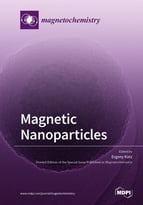Magnetic Nanoparticles
A special issue of Magnetochemistry (ISSN 2312-7481). This special issue belongs to the section "Magnetic Nanospecies".
Deadline for manuscript submissions: closed (31 August 2019) | Viewed by 115050
Special Issue Editor
Interests: bioelectronics; bionanotechnology; bioelectrochemistry; biosensors; self-assembling enzymes; monolayers; modified electrodes
Special Issues, Collections and Topics in MDPI journals
Special Issue Information
Dear Colleagues,
Magnetic nanoparticles, magnetic nanorods, and other magnetic nano-species have been prepared and used in many important applications. Particularly, magnetic nano-species functionalized with biomolecular and catalytic entities have been synthesized and extensively used for many biocatalytic, bioanalytical, and biomedical applications. Different biosensors, including immunosensors and DNA sensors, have been developed using functionalized magnetic nanoparticles for their operation in vitro and in vivo. Their use for magnetic targeting (drugs, genes, radiopharmaceuticals), magnetic resonance imaging, diagnostics, immunoassays, RNA and DNA purification, gene cloning, cell separation, and purification has been developed. Magnetic nano-objects of complex topologies, such as magnetic nanorods and nanotubes, have also been produced to serve as parts of various nano-devices, e.g., tunable fluidic channels for tiny magnetic particles, data storage devices in nanocircuits, and scanning tips for magnetic force microscopes. The present Special Issue will cover all research areas related to magnetic nanoparticles, magnetic nanorods, and other magnetic nano-species, their preparation, characterization, and various applications, specifically emphasizing biomedical applications. The Special Issue will be composed of review-style articles, which can be comprehensive literature reviews or reviews based on the author’s research activities (like concept papers). The Special Issue is planned for later conversion to a book on the same topic.
Prof. Dr. Evgeny Katz
Guest Editor
Manuscript Submission Information
Manuscripts should be submitted online at www.mdpi.com by registering and logging in to this website. Once you are registered, click here to go to the submission form. Manuscripts can be submitted until the deadline. All papers will be peer-reviewed. Accepted papers will be published continuously in the journal (as soon as accepted) and will be listed together on the Special Issue website. Only review articles are invited for this Special Issue.
Submitted manuscripts should not have been published previously, nor be under consideration for publication elsewhere (except conference proceedings papers). All manuscripts are thoroughly refereed through a single-blind peer-review process. A guide for authors and other relevant information for submission of manuscripts is available on the Instructions for Authors page. Magnetochemistry is an international peer-reviewed open access quarterly journal published by MDPI.
Please visit the Instructions for Authors page before submitting a manuscript. The Article Processing Charge (APC) for publication in this open access journal is 350 CHF (Swiss Francs). However, the review articles invited by the Guest Editor will be processed and published free of charge. Submitted papers should be well formatted and use good English. Authors may use MDPI's English editing service prior to publication or during author revisions.
Keywords
- Magnetic nanoparticles
- Magnetic nanorods
- Biomolecular-functionalized magnetic nanoparticles
- Biomedical applications of magnetic nanoparticles
- Characterization of magnetic nanoparticles
- Synthesis of magnetic nanoparticles
- Self-assembling of magnetic nanoparticles






